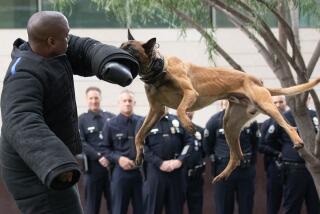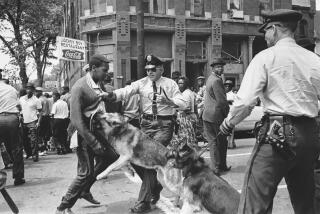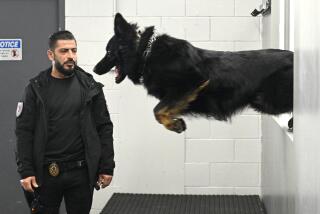A Few Good Dogs
- Share via
GRANITE, Md. — The movement is so fast, it’s a blur of fur and ferocity: Seeing his handler attacked in a training exercise, the 90-pound German shepherd is out of the patrol car’s open window and on the attacker instantly, teeth locked high on his arm.
One sharp word in Czech--”Sadni!”--from handler John Carhart, and the fight is over. The dog sits, the growling and snarling stop, and no leash or choke-chain is needed to enforce the command.
Meet Ajax, a recent graduate of the Maryland State Police K-9 training school--and one of the Czech-born, German-schooled dogs that Maryland troopers say are the future in police dogs.
The agency’s move to European dogs, prompted by their size, strength and obedience, mirrors a national trend. Skip Brewster, secretary of the U.S. Police Canine Assn., estimates that half of the nation’s 10,000 police dogs are now European transplants.
“There are still a few good dogs and breeders here in the United States,” says Brewster, a Detroit police officer and dog trainer. “But there seem to be less problems with the European dogs.”
“The dogs we were used to were extremely aggressive. They were trained by the handler and no one else could go near them,” says Sgt. James Hock of the Maryland State Police Special Operations Division, which includes K-9. “These [European] dogs are social--you can pet them.”
The agency has acquired nine German shepherds since 1993, most of them from the Czech Republic.
The dogs are not cheap--each costs from $2,900 to $3,500, depending on the amount of training they’ve had. But troopers say the investment pays off because of the dogs’ superior training and breeding, unlike the “gator on a leash” of yore.
“The Americans have diluted the bloodlines of the German shepherd,” says Cpl. W. D. Baker, who supervises canine training for the Maryland State Police at the agency’s dog academy in Granite. “You can’t find a good German shepherd here anymore.”
The European dogs are bigger and stronger, Baker says, giving them the endurance and ability to withstand the stress of police work over the eight to 10 years each dog is expected to serve.
“It’s like the difference between a truck and a car,” Baker says, comparing the European and American dogs. “The key word is genetics.”
As handlers take Ajax, Celo and Bocho through a series of training exercises, what is most remarkable is the dogs’ obedience.
The Czech word for attack--”Zadrz!”--gets the dogs jumping, growling and biting in an impressive display of force. The command to sit--”Sadni!”--and they are quiet within moments. Another command--”Lahni!”--and they lie down, immobile but alert--a posture they maintain despite balls being thrown, shots fired, other dogs passing by.
Handlers always address the dogs in Czech, the language in which they were first trained--with one exception. “Good boy!” seems to have broken the canine language barrier, setting tails wagging whenever it’s spoken. With these dogs, it’s spoken a lot.
The training can take from eight to 18 weeks, depending on the dog’s level of expertise coming in, says Baker. All K-9 dogs also come back to Baker’s training yard for monthly “maintenance” to keep their skills sharp.
A “purchased dog”--the designation troopers use to distinguish the European dogs they are buying from dogs acquired through the more traditional route of donation--arrives in this country with considerable training already under its collar.
In Europe, breeders train the dogs from puppyhood on, frequently in the discipline called schutzhund, the German word for “protection.”
The police agency buys its imported dogs from a Maryland kennel when they are 15 to 20 months old, then trains them for patrol work: tracking, attacking, searching buildings.
Baker says male dogs are used for patrols because they are bigger, stronger and more aggressive than females. For other kinds of police work, both genders and a variety of dogs are used. Labradors and golden retrievers are trained to sniff out bombs, explosives and drugs; bloodhounds remain the best tracking dogs.
More to Read
Sign up for Essential California
The most important California stories and recommendations in your inbox every morning.
You may occasionally receive promotional content from the Los Angeles Times.









